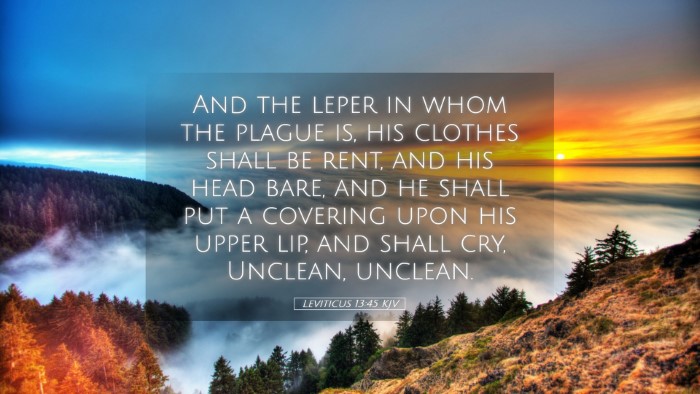Commentary on Leviticus 13:45
Verse: Leviticus 13:45 - "And the leper in whom the plague is, his clothes shall be rent, and his head bare, and he shall put a covering upon his upper lip, and shall cry, Unclean, unclean."
Introduction
This verse addresses specific regulations concerning leprosy, an ailment that rendered individuals socially and religiously unclean. The detailed instructions reflect the profound concern for community health and holiness in the Israelite camp.
Insight from Matthew Henry
Matthew Henry emphasizes the weight of social isolation that lepers experienced. He notes these regulations were not mere punitive measures but served to protect the community from infectious disease and to maintain a certain sanctity within the congregation of Israel. The act of tearing clothing and covering the lip were signs of mourning and regret associated with their condition.
- Social Implications: Henry points out that the leper's call, "Unclean, unclean," is not only a proclamation of their physical state but a significant acknowledgment of their exclusion from society, akin to a public confession of their condition.
- Spiritual Significance: The leper's state serves as a metaphor for sin in the life of the believer; just as leprosy defiled the flesh, sin taints the soul, warranting a similar acknowledgment and repentance.
Insights from Albert Barnes
Albert Barnes provides additional theological context to this command. He indicates that these laws weren't arbitrary but part of God’s larger plan for the establishment of a holy community. He interprets the physical manifestations of leprosy and the associated requirements as typological shadows of greater truths.
- Ceremonial Cleanliness: Barnes notes how the act of covering the upper lip symbolizes the seriousness of the condition. It could also signify the need for humility and submission to the divine laws that govern purity.
- Community Responsibility: He elaborates that the leper's separation served not only personal purification but also a collective safeguard. The responsibility did not rest only on the afflicted but on the community to maintain holiness.
Insights from Adam Clarke
Adam Clarke offers a detailed examination of the customs and practices associated with leprosy. He provides cultural context, suggesting that these physical signs were culturally significant markers of ritual impurity which needed addressing to preserve the communal and sacramental life of Israel.
- Historical Context: Clarke notes that the treatment of lepers in ancient Israel reflected similar practices in surrounding cultures, reflecting a common social understanding of disease and cleanliness.
- Psycho-social Impact: He also discusses the psychological toll on lepers, who lived with the constant stigma and alienation from society. The regulation promotes an understanding of compassion juxtaposed against the need for order and purity in communal worship.
Theological Themes
From the insights of these commentaries, several theological themes emerge that hold significance for modern readers:
- Recognition of Sin: The leper's declaration of "Unclean, unclean" serves as a poignant reminder for believers to acknowledge their sinfulness and need for God’s provision.
- Isolation and Redemption: The systemic separation illustrated the broader narrative of redemption; while lepers were excluded, the gospel extends to the marginalized, portraying Jesus as the one who touches the untouchable and heals the broken (Mark 1:40-42).
- Community and Responsibility: The responsibility to maintain communal health and holiness continues in the church today, urging congregations to care for one another and maintain purity, both moral and spiritual.
Conclusion
Leviticus 13:45 provides vital insights into the interplay between physical, social, and spiritual dimensions of life in covenant obedience. The regulations surrounding leprosy invite deeper reflections on holiness, community dynamics, and our responses to sin both personally and corporately. They remind us of God's desire for a holy people, the necessity of community accountability, and the gracious nature of redemption that redeems even the most marginalized among us.


